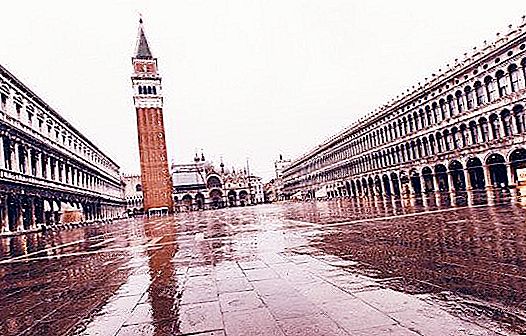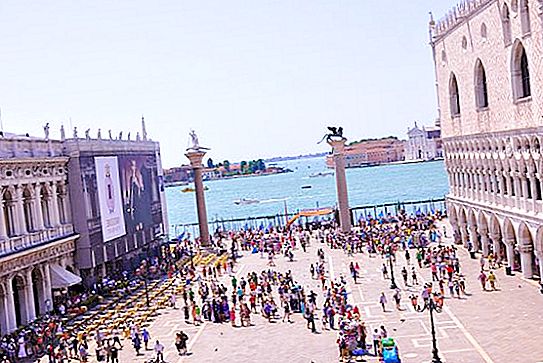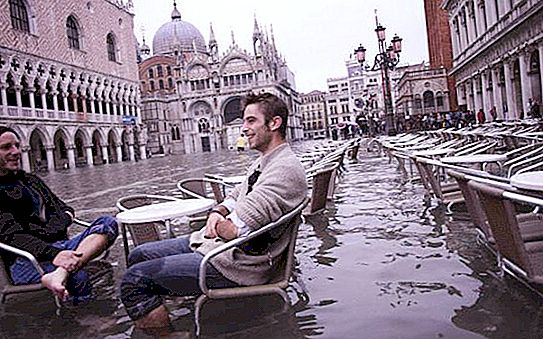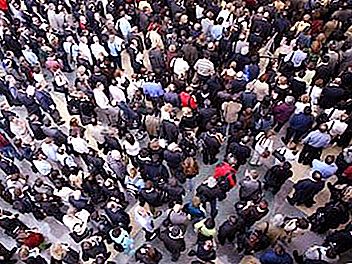Piazza San Marco in Venice (Italy) is listed in all travel guides for tourists visiting the region. It is rightfully the main one in the city. Another in the vicinity can not be compared with it either in size or in the historical, cultural, architectural sights represented there. Residents of the city are only used to calling it Piazza (the area is translated from Italian). They call all other places of similar function in Venice campo (field) or campiello (small field).
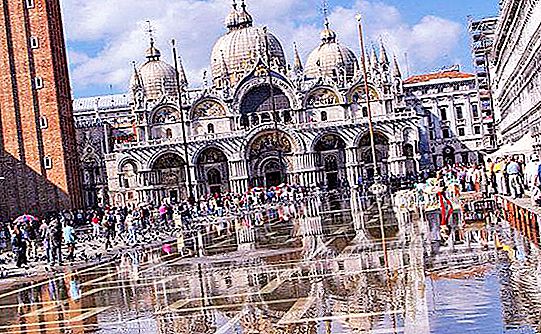
San Marco - the main square of Venice
It is customary to divide its territory into two sections. Piazza is the main and largest part of it. Piazzetta - a section overlooking the embankment. We can say that this is the gate from the sea. They are the first to be seen by tourists arriving in Venice by water. At the entrance, two magnificent columns of marble with symbolic sculptures at the top immediately come into view.
San Marco is a square shaped like a trapezoid. Its length is 175 m, the minimum width is 56 m, and the maximum is 82 m. Previously, during its formation (9th century), it was much smaller. Mentioned only a small platform opposite the Cathedral of St. Mark. Just at that time, the relics of the saint arrived in Venice. The cathedral was erected in his honor, and he began to patronize the city. Over time, the shrine was rebuilt and expanded, adding new decorations and architectural details to the already magnificent structure.
History
The place has acquired particular importance and significance since 829, when the relics of the Apostle Mark, which were taken out by merchants from Alexandria, were buried in the constructed basilica. Since then, San Marco, the square in front of the religious shrine, has also become an important pilgrimage site. In 1267, it was tiled using masonry.
For several centuries, a magnificent bell tower was built near the cathedral, which was completed only in the 16th century. Back in 1177, Pope Alexander III and Emperor Barbarossa reconciled on this square. It traditionally held important ceremonial processions, tournaments and symbolic bull hunting. After taking the oath, the Venetians carried across the square the great Doges who had entered into the rights and sat on the throne.
The organizers considered that the territory of the ceremonial place was insufficient and in 1777 it was expanded to the size existing today. Since 1807, the rebuilt St. Mark's Cathedral became a cathedral. In 1902, the famous bell tower (Campanile) collapsed on the square. But the magnificent building was restored in its original form a decade later.
sights
What else is Venice famous for? San Marco is one of the six districts of the city. It is considered the heart of the city and is known, including the famous square of the same name. The dominant place on it is Doge's Palace. He survived destruction and fires. The Senate, the Great Council, judges and even the secret police met at different times in the magnificent building. But, above all, it was the main residence of the Doges of the Republic.
In addition to the red-brick bell tower, which rises almost 99 meters and is used at night as a lighthouse for ships, the eye-catching is not such a tall, but no less famous clock tower in the surrounding architectural complex. It is adjacent to the facade of the Old Prosecutions. Of interest is the building richly decorated with statues and bas-reliefs at the base of the Campanile - Lodgetta, originally designed as a building for meeting nobles arriving in the city. One cannot but mention the exquisite two-tier facade of the National Library of San Marco. The area, according to experts, is the clearest example of medieval architectural architecture.
Modernity
It is believed that Piazza San Marco in Venice, along with the city, is gradually sinking under water. Perhaps, in the coming decades, the surrounding area will become unsuitable for living due to rising sea levels. But now all the attractions are open to tourists. The Doge’s Palace has a unique museum.
It is difficult to say what is the biggest attraction of the building - the exterior or its interior. Among the exhibits of the museum are the richest collections, trophies, maps, historical documents. You can buy souvenirs for every taste, view the majestic panorama from the observation deck at the chapel or basilica.
San Marco - Pigeon Square
Why do everyone who has been in Venice say so? There is a legend about a pair of birds, once presented to the Doge on the occasion of the coronation. Released from the cage, they sat on the consecrated arch of the built basilica. This was considered a good sign, so the pigeons were subsequently released on the occasion of Palm Sunday. The tradition led to the fact that the birds did not fly far, but settled in the area. In the square they were safe, they were constantly fed.
The authorities had to solve the problems of cleaning sights from the vital products of pigeons. Their litter did not allow tourists to fully appreciate the majestic beauty of historical and cultural attractions. On numerous arches and cornices had to install structures that distract the birds. There were periods when even restrictions on the sale of bird feed were imposed.


